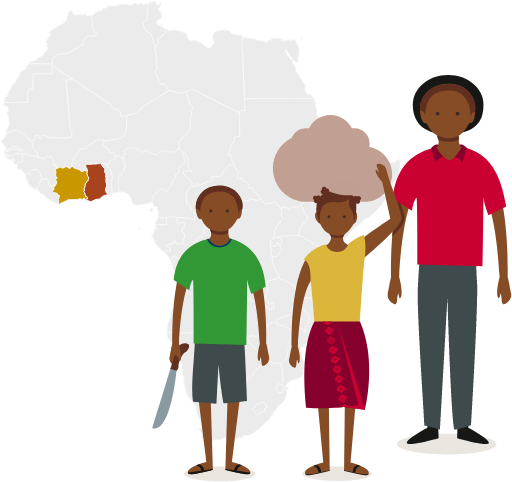An estimated 1.56 million children are in child labour in Côte d’Ivoire and Ghana.
That’s 45% of children living in cocoa-growing households. Nearly all these children work on family cocoa farms, alongside their parents and other relatives.

Child labour is a complex issue. The vast majority of cocoa in West Africa is grown by smallholder farmers. These households face the realities of rural poverty such as a scarcity of land, food insecurity, limited access to quality education, lack of access to drinking water and inadequate health services. These factors increase the risk of child labour.
What is child labour?
Child labour is defined by the International Labour Organization as “work that deprives children of their childhood, their potential and their dignity, and that is harmful to their physical and mental development”. (ILO Conventions 138 and 182 refer to child labour.)
Not all work done by children is classified as child labour. For instance, children carrying out light, non-hazardous tasks on the family farm for a limited period, under adult supervision , and without compromising their schooling, is considered acceptable child work. This type of work is often necessary for the welfare of many families. It also contributes to children’s development, providing them with skills and experience that help them prepare for adult life.
However, when activities are hazardous, such as carrying heavy loads or using sharp tools, when children work long hours, or when the work interferes with a child’s schooling, it is considered child labour and is not allowed. Both Ghana and Côte d’Ivoire have a list of hazardous tasks children are not allowed to do, as well as age-specific limits to the number of hours a child is allowed to work. Read our comparative analysis of child labour decrees in Cameroon, Côte d'Ivoire and Ghana.
Child labour is often confused with forced child labour. However, they are different. Learn more about forced labour here.
What are the risk factors?
There are many reasons why a farmer might rely on their children to help out. For example, there might not be a school close by for the child to attend, the farmer may not be aware of the dangers of certain tasks, or they may not have the funds to employ someone outside the family to help on the farm.
Several factors can increase the risk of child labour:
When families cannot afford to meet their basic needs, like food, water, or fuel, they may have no choice but to engage their children in farm work to increase household income. Most families want to protect their children from harm but are vulnerable to shocks. When faced with a sudden illness, for example, a household struggling to make ends meet may turn to child labour as a coping strategy. Families may also not have enough income to pay adult labourers to work on their farm and must rely on their children. This may compromise their schooling and can perpetuate poverty across generations. This is why we consider child labour as both a symptom and a contributing factor to the cycle of poverty.
Long distances to school, school-related costs, inadequate school infrastructure, quality of teaching, and/or availability of teachers can affect levels of attendance.
Child work is generally perceived as an important part of growing up and as a way of learning new skills. Farmers may also not be aware of the dangers of certain tasks.
At times, local adult labour is scarce because most adults are employed on their own cocoa farms and labour from elsewhere is in limited supply. This may leave farmers with no alternative but to engage their children in farm work.
Children in cocoa-growing areas are at greater risk of child labour at different times of the year, in line with the fluctuating need for labour across the seasons. Children may be called upon to work more often at specific times of the year, such as during the harvest. School holidays, when children have more free time, are also notable periods when identified cases of child labour tend to be higher.
When families make decisions regarding engaging their children in child labour, it is often the result of various factors, rather than the consequence of a single one. Tackling a single risk factor in isolation will not solve child labour. Instead, efforts should aim to address the multiple root causes.
What can be done to tackle child labour?
We believe that these complex problems can be effectively tackled through the collective, coordinated and consistent efforts of all parties involved: households, communities, governments, civil society organizations, cocoa and chocolate companies as well as other private actors active in cocoa-producing areas.
Learn more here or on the pages below.
